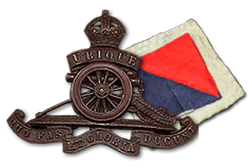1st Anti-Aircraft Brigade was an Air Defence formation of the British Army, during the Second World War, and served in the Battle of France and during The Blitz. It then transferred to the Middle East, where it defended the Eighth Army's lines of communication during the final phases of the North African Campaign.
27th Anti-Aircraft Brigade was an Air Defence formation of the British Army in the Second World War that served in The Blitz and later converted to infantry.
28th Anti-Aircraft Brigade was an air defence formation of the British Territorial Army created in 1925 to command anti-aircraft units in Kent and around the militarily important Medway Towns, which it defended during the Second World War. In 1940 the brigade was responsible for the defences on the south side of the Thames Estuary including the Royal Naval Dockyard at Chatham and the Port of Dover. The brigade was heavily engaged throughout the Battle of Britain, in the summer of 1940, and The Blitz, from autumn 1940 to spring 1941, operating a total of 70 heavy anti-aircraft (HAA) guns controlled from a gun operations room (GOR) at Chatham. During 1942 many of the brigade's experienced units were transferred to active theatres overseas. Increasingly the brigade included women of the Auxiliary Territorial Service (ATS).
The 30th (Northumbrian) Anti-Aircraft Brigade was an air defence formation of Britain's Territorial Army from 1936 until 1955, which defended Tyneside and Sunderland during the Second World War.
The 31st Anti-Aircraft Brigade was an air defence formation of Britain's Territorial Army from 1936 until 1948. During the Second World War it defended West Yorkshire and later participated in the North West Europe campaign.
The 32nd (Midland) Anti-Aircraft Brigade was an air defence formation of Anti-Aircraft Command in Britain's Territorial Army (TA) from 1936 to 1955, charged with defending the East Midlands of England.
The 34th Anti-Aircraft Brigade was an air defence formation of Anti-Aircraft Command in the British Territorial Army formed shortly before the outbreak of the Second World War. It defended the West Midlands of England during The Blitz.
The 33rd (Western) Anti-Aircraft Brigade was an air defence formation of Anti-Aircraft Command of the Territorial Army, part of the British Army, formed shortly before the outbreak of the Second World War. It defended Merseyside and West Lancashire during The Blitz.
35th Anti-Aircraft Brigade was an air defence formation of Anti-Aircraft Command in the British Territorial Army (TA) formed shortly before the outbreak of the Second World War. It defended the important naval base of Portsmouth during The Blitz.

The 71st (Forth) Heavy Anti-Aircraft Regiment, Royal Artillery was an air defence unit of Britain's Territorial Army (TA) formed in Scotland just before World War II. It served in North Africa and Italy during the war. Its successors continue to serve in the Army Reserve as part of the Royal Logistic Corps.
36th (Scottish) Anti-Aircraft Brigade was an air defence formation of Britain's Territorial Army, created in the period of tension before the outbreak of the Second World War. It was responsible for defending eastern Scotland.
The 37th Anti-Aircraft Brigade was an air defence formation of Britain's Territorial Army (TA) formed just before the outbreak of the Second World War. It was engaged in defending the Thames Estuary during the war, and continued to form part of Anti-Aircraft Command in the postwar era.
42nd Anti-Aircraft Brigade was an air defence formation of Britain's Territorial Army (TA). It was responsible for protecting the City of Glasgow and industry along the Firth of Clyde during the Second World War.

175th Heavy Anti-Aircraft Regiment, Royal Artillery was an air defence unit of the British Army formed during World War II. It served in defence of the vital naval and air base at Gibraltar.
6th Anti-Aircraft Brigade was an air defence formation of the British Army formed during the Second World War. It served in the disastrous Norwegian Campaign in 1940 and then defended East Anglia during the Battle of Britain and The Blitz. It was reorganised to take part in the invasion of Normandy, but instead was diverted to defending Southern England against V-1 flying bombs. It was briefly recreated in the postwar Regular Army.

91st Heavy Anti-Aircraft Regiment, Royal Artillery was a part-time unit of Britain's Territorial Army (TA) formed in the West Riding of Yorkshire just before the outbreak of World War II. Its service during the war included Home Defence during the Battle of Britain and The Blitz, and a length period in Middle East Forces. Postwar it continued to serve in the TA in the air defence role until 1955.
44th Anti-Aircraft Brigade was an air defence formation of Britain's Territorial Army (TA). Formed in 1938, it was responsible for protecting Manchester and later the Isle of Wight during the Second World War. It was reformed postwar under a new title, and continued until 1955.

82nd (Essex) Heavy Anti-Aircraft Regiment, Royal Artillery, was a volunteer air defence unit of Britain's Territorial Army (TA) from 1938 until 1955. During World War II it served in the Norwegian Campaign, defended Gibraltar and the D-Day invasion ports, and took part in Operation Diver against the V-1 flying bombs.

94th Heavy Anti-Aircraft Regiment, Royal Artillery, was a Scottish air defence unit of Britain's Territorial Army (TA) formed around Edinburgh during the period of international tension leading up to the outbreak of World War II. It defended Eastern Scotland during the early part of the war and then served in the North African Campaign. The regiment continued in the postwar TA until amalgamated in 1955

143rd Heavy Anti-Aircraft Regiment was an air defence unit of Britain's Royal Artillery formed during World War II. It started out as a 'Mixed' regiment with around two-thirds of its personnel being women from the Auxiliary Territorial Service (ATS). The regiment defended the West of England from 1942 to the end of the war when it moved to South East England. The regiment continued in the postwar British Army.








